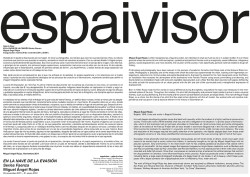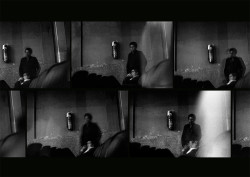space #1 - gallery
Series Faenza
Heredé de mi padre la fascinación por la imagen. Al mirar sus fotografías, los retratos que nos hizo cuando niños es notorio el esmero que ponía en sus puestas en escena y evidente el interés de nosotros al posarle. Con su cámara Kodak 1A logró composiciones sorprendentemente equilibradas. Esa misma cámara sería mi primera herramienta en el campo de la imagen. Con ella hice, a principio de los sesenta, mis primeras largas exposiciones, autorretratos nocturnos uno de ellos con luz de luna. En los setenta, influenciado por el fotorrealismo, compré mi primera cámara de 35mm, una AsahiPentax, y realicé tomas de larga exposición las cuales serian determinantes en el trabajo de los cines.
Más tarde conocí el conceptualismo por el que me enfoqué en la realidad, mi propia experiencia y mis relaciones con el medio social, haciendo de ellas la plataforma ideológica de los procesos de creación y el fotorrealismo, importante también para definir la imagen fotográfica como expresión formal.
La serie El Emperador del 73 fue mi primer intento de documentar con la cámara las vivencias en los cines, en concreto en el Imperio, una sala tipo B, hoy desaparecida. En el momento aquellas imágenes desenfocadas no capturaron mi interés y seguí recreando con la cámara en el estudio aquellos lugares de encuentro posando en ropas de jeans y cuero. Después de algunos dibujos y grabados apoyados en copias fotográficas, tomé la arriesgada decisión de hacer de la fotografía, una disciplina ajena en aquellos días a las bellas artes, el medio definitivo.
A mediados de los setenta inicié el trabajo en la gran sala del teatro Faenza, un edificio deco–noveau venido a menos por los desplazamientos sociales que transforman constantemente estas ciudades siempre en movimiento. En aquellos años era un cine, donde continuamente se proyectaban cintas de karatecas y vaqueros, que se había convertido en lugar de encuentros gay. Después de muchos intentos logré perfeccionar el sistema que me permitiría sin trípode, sin flashes, sin la posibilidad de encuadrar y enfocar a través del visor, obtener imágenes legibles. Llevaba la cámara totalmente cubierta de cinta adhesiva negra dentro de un maletín, con la luz de una pequeña linterna hacía los ajustes de foco y diafragma, calculaba la distancia al lugar de interés contando el número de sillas, entonces anclaba la cámara a un brazo de la silla con plastilina limpiatipos (museumgom), con un disparador obturaba y sostenía la apertura unos treinta segundos, después en el revelado forzaba la película alargando la operación cuatro veces más. A finales de la década había obtenido unas cien fotografías en todos los rincones cómplices del lugar, documentos de ese oscuro mundo en el que el transcurso del tiempo parecía suspenderse y que a la postre fueron la recuperación del mismo.
Aquellas imágenes son la base de la primera parte del video Corte en el Ojo en las que pequeños recorridos y destellos estroboscópicos animan las escenas lejanas en el tiempo. La segunda parte es un nostálgico traveling hecho casi tres décadas después en los palcos ruinosos y cerrados de ese magnífico interior poco antes de ser rescatado por una de las universidades bogotanas, ahora restaurado es su aula máxima. Buen final para un lugar de mis recuerdos, algunos no tan agradables, después de todo era un lugar público en el centro deprimido de una ciudad latinoamericana. El titulo del video alude a un ataque que sufrí por parte de un parroquiano quien al percatarse de mi actividad documental se levanto repentinamente y me golpeo la cara, una esquirla de mis lentes hirió la córnea de mi ojo izquierdo.
Las series Faenza fueron el punto de partida de mi producción siempre vinculada a mi propia experiencia y al sentido crítico, no encuentro otra manera de ser sensible y de hacer arte en un país en formación, donde la identidad del mismo no se ha definido del todo y en el que algunos factores compartidos con el primer mundo nos sitúan en dependencia neocolonial, tal es el caso de fenómeno de la producción y el consumo de drogas.
Miguel Ángel Rojas, Noviembre 2011
Miguel Ángel Rojas is often recognized as a figurative artist, not interested in style as much as he is in subject matter. It is on these grounds where he comes to term with conceptual, symbolical and political themes such as marginality, sexual difference, indigenous politics, social displacement, and most recently, the situation of the country: more specifically, political violence related to drug trafficking.
Printmaking and photography have been relevant in the process of academic formation that Rojas took at the National State Univesity. Photography is precisely one of the media with which the artist has experimented the most, working with fragmentary enlargements, reductions to minimal scales and partial developments, that cast the referent for his most recognized works: Su3?eti;o, an installation that recreates the atmosphere of the bathrooms in the Faen6a Theatre using sound, printmaking and drawing; and 9rano (Grain) an installation made with soils and vegetable coal powders over a floor that has been covered with paper, defined by the artist as both the construction of an urban ground with the dirt and soil of the countryside and a metaphorical expression of displacement.
Born in 1946, Rojas made his first works on sexual difference during the eighties, long before the topic was introduced in the international sphere of the arts. Throughout the nineties, the artist left photography and personal topics aside to arrive to more universal themes, such as drug trafficking, the third world and the uneven concentrations of power, amongst others. The work of Miguel Ángel Rojas, as a whole, has the stamp of an artist that has kept certain distance with the art market, has worked with vast creative independence and has grown to be a decisive referent in the history of Colombian art.
Miguel Ángel Rojas
Bogotá, 1946. Lives and works in Bogotá Colombia.
His work began reconfiguring certain issues that dealt with sexuality within the context of a highly traditional conservative society. These early works (1979) revealed what was and still is relegated to the shadows—a private space of homosexuality, which at that momento had not yet been articulated in Colombian art. Small circular black and white photographs taken at the toilets of the Faenza Theatre (An art deco theatre in downtown Bogotá that in the 70s only screened karate films) seemed to implicate the spectator in voyeuristic acts from which he/she might normally claim distance. The scale and resolution of the images required the careful attention of the spectator, who rapidly stepped back from these small photographs when he or she clearly identified the homosexual encounter that was occurring right in front of their eyes.
Nowadays those physically small but conceptually strong pieces are still small circles of desire, where once again what seems to be socially kept a secret, rather than hidden, is cautiously brought out to light by Miguel Angel Rojas with his peculiar cynicism, irony and humour: In his most recent work he has created paradoxical situations that coexist within the logic of narcotraffic: He has copied images that represent progressive Anglo-Saxon capitalism such as Marlboro ads and Pop-art paintings made by Roy Lichenstein and Richard Hamilton, but has reproduced all of them with small circular coca leaf and dollar bill cutouts. Since then, coca leaves as material and as a testament to political policies that confront the drug-problem in Colombia, have influenced Rojas’s artistic practice. Rojas has produced works in different mediums including Santa: a large-scale photograph landscape of a foggy forest of Los Andes, in all its beauty, which Rojas juxtaposes with a digital symbolic rain of glyphosphate over its inhabitants, flora, water and soil.
The work of Miguel Ángel Rojas has been extensively shown and acquired by different institutions, among others: The Sao Paulo and Havana Biennials. Museum of Modern Art (New York); Daros-Latinamerica Collection (Zurich) Ludwning Museum; Whitney Museum of American Art (New York); “La Caixa” (Barcelona).

